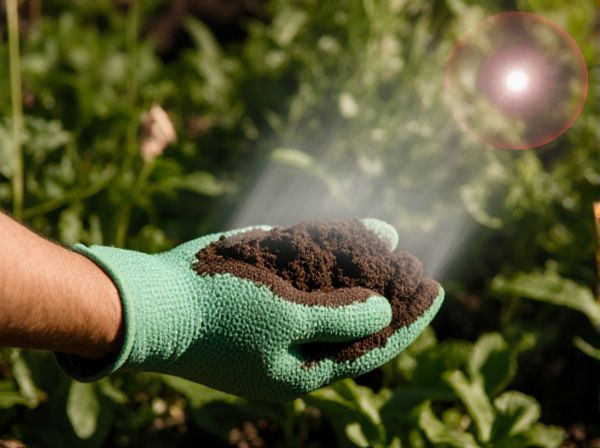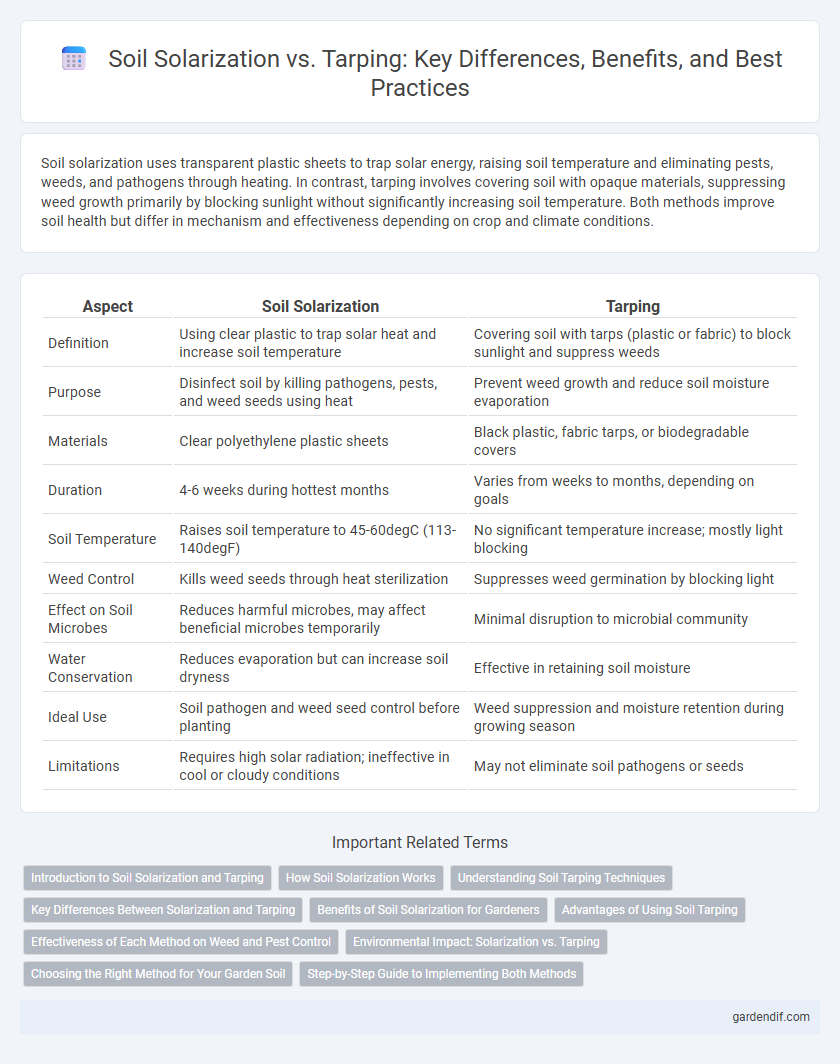
Soil solarization vs Tarpping Illustration
Soil solarization uses transparent plastic sheets to trap solar energy, raising soil temperature and eliminating pests, weeds, and pathogens through heating. In contrast, tarping involves covering soil with opaque materials, suppressing weed growth primarily by blocking sunlight without significantly increasing soil temperature. Both methods improve soil health but differ in mechanism and effectiveness depending on crop and climate conditions.
Table of Comparison
| Aspect | Soil Solarization | Tarping |
|---|---|---|
| Definition | Using clear plastic to trap solar heat and increase soil temperature | Covering soil with tarps (plastic or fabric) to block sunlight and suppress weeds |
| Purpose | Disinfect soil by killing pathogens, pests, and weed seeds using heat | Prevent weed growth and reduce soil moisture evaporation |
| Materials | Clear polyethylene plastic sheets | Black plastic, fabric tarps, or biodegradable covers |
| Duration | 4-6 weeks during hottest months | Varies from weeks to months, depending on goals |
| Soil Temperature | Raises soil temperature to 45-60degC (113-140degF) | No significant temperature increase; mostly light blocking |
| Weed Control | Kills weed seeds through heat sterilization | Suppresses weed germination by blocking light |
| Effect on Soil Microbes | Reduces harmful microbes, may affect beneficial microbes temporarily | Minimal disruption to microbial community |
| Water Conservation | Reduces evaporation but can increase soil dryness | Effective in retaining soil moisture |
| Ideal Use | Soil pathogen and weed seed control before planting | Weed suppression and moisture retention during growing season |
| Limitations | Requires high solar radiation; ineffective in cool or cloudy conditions | May not eliminate soil pathogens or seeds |
Introduction to Soil Solarization and Tarping
Soil solarization uses solar energy to heat the soil by covering it with transparent polyethylene sheets, increasing soil temperature to levels that suppress soilborne pathogens, weeds, and pests. Tarping involves covering soil with various types of tarps, including opaque or reflective materials, to protect the soil surface, conserve moisture, and reduce weed growth. Both methods enhance soil health and crop productivity but differ in their mechanisms of heat retention and pest control efficacy.
How Soil Solarization Works
Soil solarization works by covering moist soil with clear plastic sheets, trapping solar radiation and raising the temperature to levels lethal for many soilborne pathogens, weeds, and pests. Temperatures typically reach 45-60degC (113-140degF) within the top 15-20 cm of soil, effectively sterilizing the soil environment during 4-6 weeks of summer exposure. This process enhances soil health by reducing reliance on chemical fumigants and promoting beneficial microbial activity.
Understanding Soil Tarping Techniques
Soil tarping involves covering the soil with heavy-duty polyethylene or fabric tarps to suppress weed growth, conserve moisture, and moderate soil temperature, enhancing soil health and crop yield. Unlike soil solarization, which relies on transparent plastic to trap solar heat and eliminate soil pathogens, tarping provides a physical barrier that prevents weed emergence and erosion without necessarily increasing soil temperature. Effective soil tarping requires selecting appropriate tarp material, ensuring complete soil coverage, and timing the application to align with crop rotation and climatic conditions for optimized soil productivity.
Key Differences Between Solarization and Tarping
Soil solarization uses solar heat trapped under transparent plastic to raise soil temperatures, effectively controlling soilborne pests and pathogens, while tarping relies on covering soil with various types of tarps to suppress weeds and moisture loss without significantly increasing temperature. Solarization typically requires several weeks during hot seasons to achieve pathogen control, whereas tarping can be performed year-round primarily for weed management and soil moisture conservation. The choice between methods depends on specific agricultural goals, climate conditions, and desired outcomes for soil health and pest control.
Benefits of Soil Solarization for Gardeners
Soil solarization enhances soil health by using solar energy to elevate soil temperatures, effectively reducing soil-borne pathogens, weeds, and pests without chemical pesticides. This method improves nutrient availability and soil structure, promoting healthier plant growth and increased yields. Gardeners benefit from a sustainable, eco-friendly technique that reduces reliance on harmful chemicals and fosters long-term soil fertility.
Advantages of Using Soil Tarping
Soil tarping offers significant advantages including long-term weed suppression by blocking sunlight and maintaining soil moisture, which enhances microbial activity and soil health. Unlike soil solarization, tarping can be used in various weather conditions and does not rely on high temperatures, making it effective year-round. It also reduces soil erosion and nutrient loss, contributing to sustainable agricultural practices.
Effectiveness of Each Method on Weed and Pest Control
Soil solarization utilizes solar radiation to raise soil temperatures, effectively reducing weed seed viability and controlling soil-borne pests by creating a hostile environment for their survival. Tarping, which involves covering soil with physical barriers, suppresses weeds primarily by blocking sunlight and can also limit pest access, but may be less effective against soil-dwelling organisms compared to solarization. Studies show that soil solarization achieves higher weed mortality rates and more comprehensive pest suppression, especially in warmer climates, while tarping serves as a cost-effective, albeit less thorough, alternative for integrated pest management.
Environmental Impact: Solarization vs. Tarping
Soil solarization employs solar energy to heat the soil, reducing pathogen levels without chemical inputs, thereby minimizing environmental contamination. Tarping, though effective at suppressing weeds and conserving moisture, often uses plastic materials that contribute to waste and potential microplastic pollution. Solarization offers a more sustainable solution by leveraging renewable energy and decreasing reliance on synthetic covers.
Choosing the Right Method for Your Garden Soil
Soil solarization uses clear plastic to trap solar energy, raising soil temperatures to eliminate pests, pathogens, and weeds, making it ideal for warm, sunny climates with extended summer periods. Conversely, soil trapping involves covering soil with opaque materials for moisture retention and weed suppression, suitable for cooler regions or gardens needing enhanced soil moisture conservation. Selecting the right method depends on local climate conditions, soil type, and specific garden needs to maximize soil health and crop productivity.
Step-by-Step Guide to Implementing Both Methods
Soil solarization begins by moistening the soil and covering it with clear plastic sheeting for 4-6 weeks during the hottest months to trap solar energy and elevate soil temperature, effectively controlling pathogens and weeds. Tarping involves placing opaque or colored tarps over the soil to block sunlight and suppress weed growth, typically used for 4-8 weeks depending on climate conditions. Both methods require thorough soil preparation, including clearing debris and ensuring even soil moisture, to maximize heat penetration and treatment efficacy.
Soil solarization vs Tarpping Infographic

 gardendif.com
gardendif.com